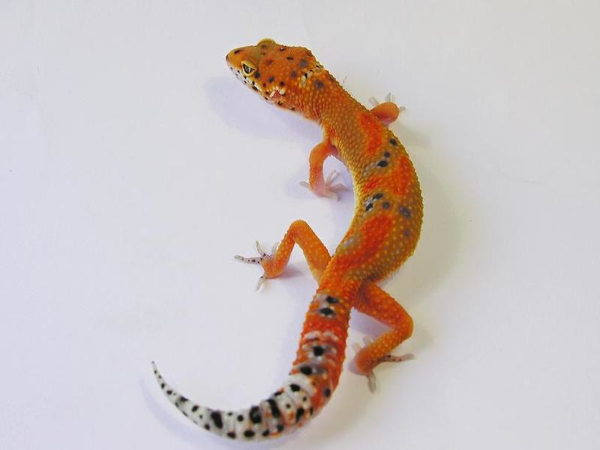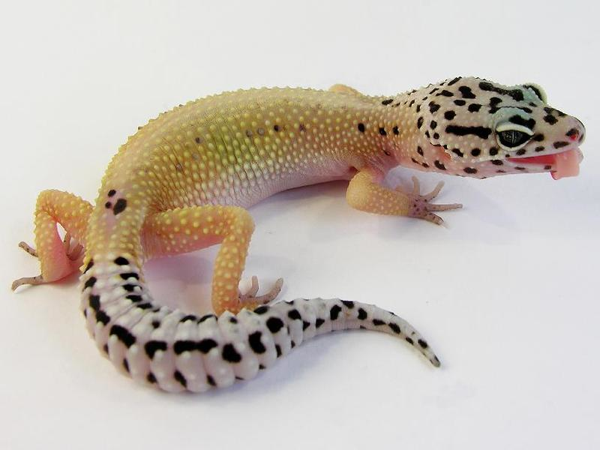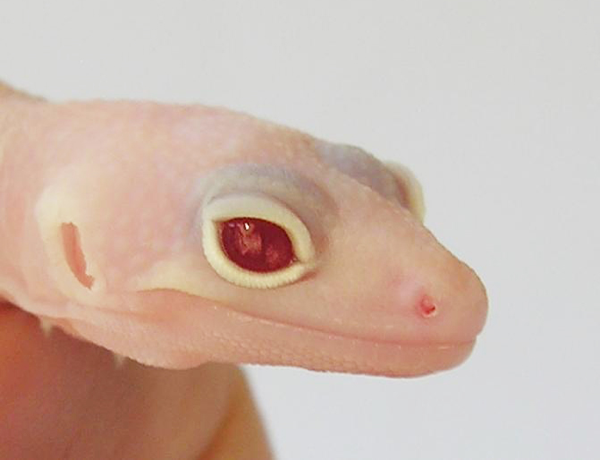Everybody wants to breed healthy and beautiful leopard geckos, right? So how come this topic is still such a big issue for newcomers, and also often a sticking point for hobbyist breeders?
The following article will try to scratch the surface a bit in terms of what breeding management is about, and hopefully help you to get a better idea of how to reach your goals.
The Secret…
Let me tell you a secret about breeding that really shouldn’t be one:
Of the millions of geckos produced every year, there are thousands with good enough quality to meet even the strictest breeding standards. A good number of them are produced by bigger and smaller scale breeders alike, and are more than affordable in price for their quality – so why trouble yourself by using second rate animals for producing your precious offspring 😉 ?? If you think about this question carefully, it will open a path for you and you will finally be able to discover and select good from bad breeders for your colony. Only then will you be able to improve the quality of your stock, and reach your breeding goals.
Ready for a change? Then lets get started!!
First Cut is the Deepest
This may sound hard and it surely is: as a responsible breeder, you must strictly divide your whole gecko colony into two groups — the pets and the breeders. The first category will consist of every sweet little thing your heart hangs on to. Each will be loved and cared for and live a happy life at your home. The second group will contain only animals that are 100% perfectly healthy in all categories. Naturally, the second group should be much smaller than the first one if you have done your job correctly and not fooled yourself. Remember, you are reading this article not because you simply want to produce geckos — you want to produce the ones that not only look stunning, but are also strong, healthy and fertile. Just because a gecko in your stock will not be used for reproduction doesn’t mean that you love it less for what it is. The gecko will most likely also enjoy a life without the stress of reproduction.This method of dividing your stock into two parts is very effective, as it not only sharpens your eye for true Quality, but also saves you a lot of very expensive troubles and genetic disasters in the end.
One of the most important pieces of advice that I can give you about breeding goes as follows:
“When you want to breed quality, stop thinking with your heart and start planning with your head!”.
Separating the Seeds
So we already figured out the most important rule: stop thinking every gecko you have bought or will buy in future can make a good breeder. But how do you choose the ones which will most likely bring you the desired results? As a start, a good breeder will fit 100% in the following categories:
1. Anatomy
Never ever consider using a leopard gecko for breeding if it does not have a correct anatomy! This includes straight bones and natural angles on the joints. A gecko will be disqualified it if has abnormalities such as an over- or underbite, eye deformities etc. Also check the whole spine carefully for any irregularity.
Any of the deformities mentioned above might be a sign the animal suffers from MBD (Metabolic Bone Disease)! Be aware that MBD can not only come from bad nutrition, but also from a genetic disposition for weak or “glass” bones which you surely do not want to add into your gene pool!
There has been a lot of discussion in the past as to whether you should breed geckos with minor faults and deformities. The fact is: We do not know for sure the extent to which any anatomical deformity is genetically passed on to future generations. On the other hand, some deformities such as slight tail kinks have not been found to be 100% genetic yet. There is no simple answer to that question, so the desicion is up to you. I personally prefer to play it safe and never use such animals in breeding.
Whether I buy new breeders or choose my holdbacks for the new season, I always put anatomy and behavior first and before anything else, simply due to the fact that color and improved pigmentation are much easier for me to produce than better health.
In contrast, trying to breed traits like infertility or MBD out of my colony where I do not even know the genetics behind the geckos in question is often a lost battle right from the start.
People often think breeding a trait out of your colony is easy. It is not, and especially not with polygenetic traits like slow growth, low fertility, and general weakness. If someone really tries to breed those things out, he or she really needs advanced knowledge in genetics, plus the willingness to work hard over several years. Such things cannot be eliminated from your gene-pool just after a few generations. You have to invest a lot of time, money (you will need unrelated, TOP healthy breeders to cross with the “sick” ones) and detailed data collection in order to make this work. And guess what? You’ll probably still have some percentage of offspring every year that displays the undesired trait and that you can not sell.
Therefore, I really see no sense in using animals with undesired traits at all in a breeding program, and consider it a waste a lot of time and money in a “project” where the outcome is more than unsure and often nothing but frustrating. Better to start from the beginning with animals whose production you can be sure of, and proceed from there. I bet you will more quickly improve your color over 2 or 3 generations with healthy geckos as opposed to spending your time trying to breed weak bones and slow growth out of your colony..
In addition, no one will buy sick offspring. If you want to be taken seriously as a breeder, the least other breeders and buyers expect from you is to produce animals that are healthy, growing well and fertile. With enough excellent and promising geckos available on the market, I find it more satisfying to invest in one gecko of excellent breeding quality for replacement than to waste my precious time and money in taking the risk that I will produce weak or deformed offspring because of an abnormality in the parent.
2. Behavior
This point is often forgotten or not taken seriously in gecko hobby breeding, but it cannot be stressed enough. Scientific research clearly shows that aggressive and shy behavior of the parents can be genetically passed to their offspring in almost all species (not only mammals) at least to some degree. In the wild, aggressive behavior can come in handy in the search for fitting partners or in the fight for territory or food. With domesticated animals however such as our leopard gecko color morphs (which are clearly bred as pets only!), aggression towards other leopard geckos and humans is an undesireable and sometimes even a counter-productive feature: We all agree that many leopard gecko color morphs could not survive in nature with their bright colors. Therefore, color morph leopard geckos will most probably never be used in any future reintroduction programs in the wild. As a consequence, such animals totally depend on human care.
Aggressive behavior towards humans makes the daily routine more difficult as any handling or even manipulation of the cage will put such an animal under serious stress.
“Tame” geckos which show no fear of their owner or even seem to like interactions from time to time are definitely able to enjoy a more relaxed and stress free existence in our homes. As a responsible hobbyist and color morph breeder, producing geckos that are able to live a relaxed and happy life with their new owners should be a top priority!
Between 2007 and the present, Dragoon Gecko has linebred several color morphs. I realized that often agressive or tame behaviour (at least in my stock) was not influenced as much by incubation temperature as I thought it would be, but surprisingly, more by who the parents were. The complete results of these findings would fill another article, so we will not go too much into detail here.
In general, you can say that calm, tame but active and curious geckos make better breeders, as they can handle the daily routine of feeding, cleaning and ocasional handling and veterinary checks etc. better and with less stress than the “screamers”. “Tame” geckos also have, in my personal experience, a higher chance of passing this temperament on to their offspring. In general, based on my own experience, pairing agressive x aggressive or aggressive x tame geckos has given me a significantly higher percentage of “screamers” than the Tame x Tame pairings over the years.
I also sucessfully used “tame” males that stongly passed this characteristic to the offspring in order to genetically “fix” some not so tame lines, but this really requires advanced knowledge of genetics, patience and detailed data collection over several generations to work out.
In conclusion, I can say the following: If you have some extremely aggressive animals and want to save time and money, think twice before using them for breeding and consider switching to a more suitable individual or pair. Not only will your customers be very thankful, it will also make your life and that of every baby gecko easier, more relaxed and more fun :-).
3. Phenotype
Now to the point most people think about when choosing geckos, but also an area where many fail to go into details. As discussed in my previous Gecko Time article (What to Expect as a First Time Breeder), even with simple recessive or co-dominant traits such as the Mack Snow for example, many additional polygenetic factors can be deciding factors in how bright the color will be, how much spotting will occur etc. So, how to choose the best animal? Here is the plan that I always teach people to use and that also works best for me:
First- Search the internet. Have a look alround and do your homework to find out what makes high and what makes low quality in the particular morph you are interested in.
Make sure you write down every point so you don’t forget anything later.
Second- check your budget, and plan from there. There are usually two ways to choose:
♦ If you are 100% sure what you want and what you do not want, select the best fitting animal, and invest in top animals where you can be sure they will give you exactly what you want and will not waste your precious time.
♦ If you only have a limited budget, then if possible invest your money in one (!) animal and try to get the very best quality for the price you can afford. Then save again for a fitting breeding partner as you let the other grow. This system can work out great in many cases IF you concentrate on getting very few animals for your money. Be aware though that this way you still may need several years of hard work and selective breeding to get to the level you want.
Whatever you do- NEVER make the mistake of buying too many animals with a limited budget, as cheap purchases will result in the very situation you want to avoid! Better to have few good quality breeders than a bunch of bad ones!!
4. Genotype
This topic is another really important one in your goal to strive for quality:
Let’s say you want to buy a Snow. You’ll soon discover that there are many Snows for sale out there- but which one will give you the clear white colored offspring with the reduced spotting you desire??
The answer often lies in the genetic history of the particular animal. This means that if the parents and maybe grandparents displayed the quality you desire, chances will be much better that you will get what you are looking for than if you buy a gecko with an unknown history.
Be aware though that linebreeding for high quality costs the breeder a lof of effort and money, which will make these animals usually more expensive than “by-products” or a first-time breeder’s offspring or geckos produced by someone not really caring about genetics. First ones usually do have better chances to produce what you desire.
5. Individual performance of the animal
This step will take place after you purchase and select your breeding colony based on the points mentioned above. Why is it so important? Well, you already found yourself nice looking animals with good potential based on the selection above – now you want to see which ones will still stay awesome not only in theory, but also in breeding practice!
When it comes to breeding, keeping track of several factors is essential in order to recognize which animals can reproduce the way you want them to and fulfill the hopes put into them- and which ones to exclude from your breeding program as they will reproduce undesired traits.
Keeping track of these tendencies will include primarily for males how they mate (for example, I never allow aggressive males to mate with my females. But I also exclude males with a low libido as this could be a sign of inbreeding and therefore lead to a higher rate of infertility in the future).
In females I check the amount of eggs in the the first and second year – females that lay few and mostly infertile eggs over a 2 year period will be excluded from my program. They also should not look like skeletons during breeding season, especially not in their second year!! I want my females to be fertile and strong and able to easily handle the breeding season. This is the way Mother Nature also selects for health and fertility!
Another important point for both males and females is the quality of offspring they produce: If a gecko cannot reproduce at least the same quality in even one (better more!) of its offspring with two different mates (over a two-year period), it should be retired as a breeder. Advanced breeding is about improving, not simply reproducing!
The same goes for any of my geckos, no matter how cute or pretty or “special” he or she might be that produces significantly small, weak, or slow-growing offspring. Breeding for quality simply will not succeed over a long term if the basic points (anatomy, fertility, constitution etc.) are not the first priority above anything else. And guess what? Even if it hurts sometimes, I can assure you that I have ALWAYS found a suitable replacement for any breeder or holdback that was removed from my breeding plans. Many times the strongest sibling has produced strong and equally amazing offspring with the right and carefully selected partner for me the next season, or I found a great new gecko from another breeder to take on the job.
Last but not least: Only choose to hold back for breeding those of your offsping that can at least display the very same quality as their parents in the aspects mentioned above . This means in my case that I will not have a holdback every year to carry on the next generation in a project. But being strict here is for sure the quickest and most sucessful way for improvement and the point that makes a difference :-).
One Last Piece of Advice
This article can only give a short overview about some important points. Everybody seriously interested in breeding on a high quality level should read and learn basic genetics, heritability of traits and the process of linebreeding carefully. Also, actually writing your own breeding and selection plans based on your individual goals will help you to maintain a good overview and a clear head all the time ;-). Don’t be afraid to get started, as these plans and mind-maps will become more and more accurate, detailed and useful due to your practice after a few tries.
In my breeding, I have never put together one single pairing without carefully doing the paperwork first. It surely is a system that has proven to save me much time and effort as it keeps me focused on my major points without losing all the details and minor points in the process.
I hope this article has opened your eyes to the priorities when it comes to breeding, and encourages some of you to go a bit deeper into genetics and population health management :-).
Note: All the geckos pictured in this article were produced by Rebecca Hassler and are testaments to her commitment to health and quality in her breeders.





Excellent article, Rebecca. Your points are quite salient and the key to better Leopard gecko breeding. We should all strive to breed better geks every season. I especially like your point about starting with quality geckos. Yes, you can pay $900 or $90 for quality geckos; you just might have to pay more for a morph that is more rare and harder to find. But that choice is yours. And choice is what your article was really about.